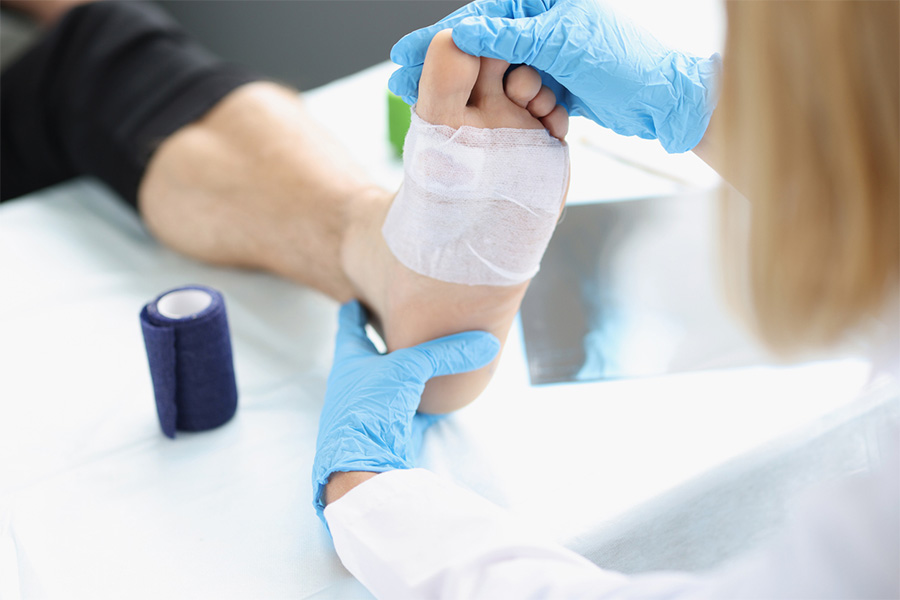Foot warts also referred to as plantar warts, are small lesions that develop on the foot’s weight-bearing areas, such as the heels. Foot warts develop when a strain of the human papillomavirus (HPV) that causes foot warts enters a cut, break, or weak spot on the bottom of your foot.
Foot warts are typically self-limiting and are a generally harmless condition; they go away on their own after one to two years. Nonetheless, they are contagious and can spread to other parts of the body. They can also be painful, itchy, and/or give you a feeling of pressure on your foot. Increased friction on your foot may exacerbate these symptoms and cause your foot warts to bleed.
Fortunately, there are a variety of ways to manage foot warts and keep them from spreading. Let’s learn what these are and where to seek high-quality foot wart treatment in Cincinnati, Ohio.
Dealing with Foot Warts
Basic remedies for foot warts include over-the-counter medications, such as salicylic acid liquid, patches, or ointments. You’ll need to take certain precautions to avoid worsening your condition. Warts thrive in moist and damp environments. Keep your feet dry as much as possible, especially before wearing socks and closed shoes.
Listed below are some more simple tips on how to deal with your foot warts:
- Clean your feet thoroughly with soap and warm water.
- Change your socks daily.
- Air dry your shoes and store them only when dried.
- Use a separate towel for your foot.
- Wear flip-flops while walking in public showers and swimming pools.
- Refrain from scratching, touching, or picking at your warts.
- Peel off your dried-out warts with pumice stones or emery boards and disinfect these tools afterward to avoid transmission.
It is worth noting that people who contracted warts before are at a higher risk of developing them again. That is to say, foot warts can reappear even after treatment. Consider the tips mentioned above to prevent any recurrence.
Seeing a Foot Doctor for Your Foot Warts
If your warts are painful or spreading and home remedies don’t seem to help, it proves prudent to have them seen and treated by a foot doctor. The following are a few of the methods foot doctors use to address foot warts:
Cryotherapy
Cryotherapy is an in-office procedure that involves freezing your wart using liquid nitrogen, either with a cotton swab or a spray. Application of liquid nitrogen typically takes less than a minute. Cryotherapy can be painful, so your foot doctor will likely numb the affected area on your foot prior to the procedure.
Laser Treatment
Foot warts can also be removed using laser treatment— particularly pulsed-dye laser treatment. Laser treatment for foot warts is a generally safe and tolerable procedure. It is aimed at heating and destroying the tiny blood vessels inside the wart and attacking the virus that causes the wart.
The laser beams may feel like rubber bands being snapped against your skin, but such discomfort gradually subsides after the procedure.
Surgical Excision
Surgical excision is another in-office treatment for foot warts. It involves cutting away or destroying the foot warts using an electric needle (electrodesiccation and curettage). Like cryotherapy, surgical excision can also be painful, so your foot doctor may also apply a local anesthetic to number the affected area on your foot.
Since surgical excision poses a risk of scarring, your foot doctor will only recommend this procedure after they have tried all other options to no avail.
Foot Wart Treatment in Cincinnati, OH
If you’re bothered by your foot warts and seeking an effective treatment for them, see one of our board-certified foot doctors here at Cincinnati Foot & Ankle Care. We offer a wide variety of in-office treatment modalities for foot warts. We will work with you to evaluate your condition and recommend the course of treatment that best suits your needs.
To arrange a consultation with one of our foot doctors, call our office nearest you. Alternatively, you can fill out our secure appointment request form.





